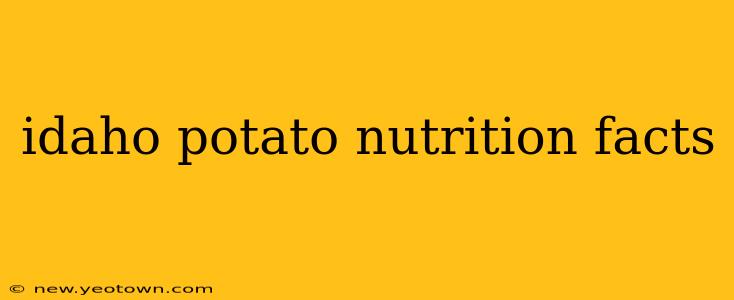Ah, the Idaho potato. A culinary staple, a comforting side dish, and the star of countless recipes. But beyond its delicious versatility, lies a nutritional powerhouse often overlooked. This isn't just a starchy vegetable; it's a surprisingly good source of essential vitamins and minerals. Let's peel back the layers (pun intended!) and delve into the nutritional profile of this iconic spud.
Our story begins in the fertile fields of Idaho, where these potatoes soak up the sunshine and rich soil, developing their characteristic creamy texture and subtly sweet flavor. But what exactly are we getting when we add an Idaho potato to our plate?
What are the nutritional benefits of Idaho potatoes?
Idaho potatoes are a surprisingly good source of several essential nutrients. A medium-sized baked Idaho potato (about 5.3 ounces or 150 grams) provides a decent amount of potassium, vitamin C, and vitamin B6. These nutrients play vital roles in maintaining our overall health and well-being. Potassium helps regulate blood pressure, vitamin C supports the immune system, and vitamin B6 is crucial for brain development and function.
Beyond the vitamins and minerals, potatoes also offer dietary fiber. Fiber is essential for digestive health, helping regulate bowel movements and preventing constipation. While not as high in fiber as some other vegetables, the fiber in potatoes still contributes to a healthy gut.
How many calories are in an Idaho potato?
Calorie count is often a primary concern. A medium-sized baked Idaho potato contains approximately 161 calories. This calorie count can fluctuate slightly depending on the size of the potato and how it's prepared. Adding butter, sour cream, cheese, or other toppings will, of course, increase the overall caloric intake.
Are Idaho potatoes good for weight loss?
This is a question with a nuanced answer. While potatoes themselves aren't inherently fattening, portion control and preparation methods are key. A baked potato with minimal additions can be a part of a healthy weight-loss diet. However, loaded baked potatoes with high-fat toppings can quickly become calorie-dense. The key is mindful eating and balanced nutrition.
What are the different ways to prepare Idaho potatoes?
The beauty of the Idaho potato lies in its versatility. Baked, mashed, roasted, fried – the possibilities are endless! However, how you prepare your potato significantly impacts its nutritional value. Baking or boiling your potato retains more nutrients than frying, which can lead to higher fat and calorie content. Experiment with different herbs and spices to enhance flavor without adding excessive calories or unhealthy fats.
Are Idaho potatoes a good source of protein?
While potatoes are not a primary source of protein, they do contain a small amount. A medium-sized potato provides approximately 2 grams of protein. This isn't significant enough to rely on potatoes as your main source of protein, but it still contributes to your overall daily intake.
What are the potential downsides of eating Idaho potatoes?
While generally healthy, consuming excessive amounts of potatoes can lead to some drawbacks. High levels of starch can contribute to blood sugar spikes, especially in individuals with diabetes or insulin resistance. Also, potatoes contain solanine, a naturally occurring compound that can cause digestive upset in large quantities. Moderation is key to enjoying the benefits of potatoes without experiencing these potential downsides.
Conclusion: A Balanced Perspective
The Idaho potato, far from being a nutritional villain, is a versatile and nutritious vegetable when consumed in moderation and prepared healthfully. Its rich vitamin and mineral content, alongside its fiber contribution, makes it a valuable addition to a balanced diet. Remember to choose preparation methods that minimize added fats and calories, and always practice portion control to reap the full nutritional benefits of this iconic spud. Enjoy!

